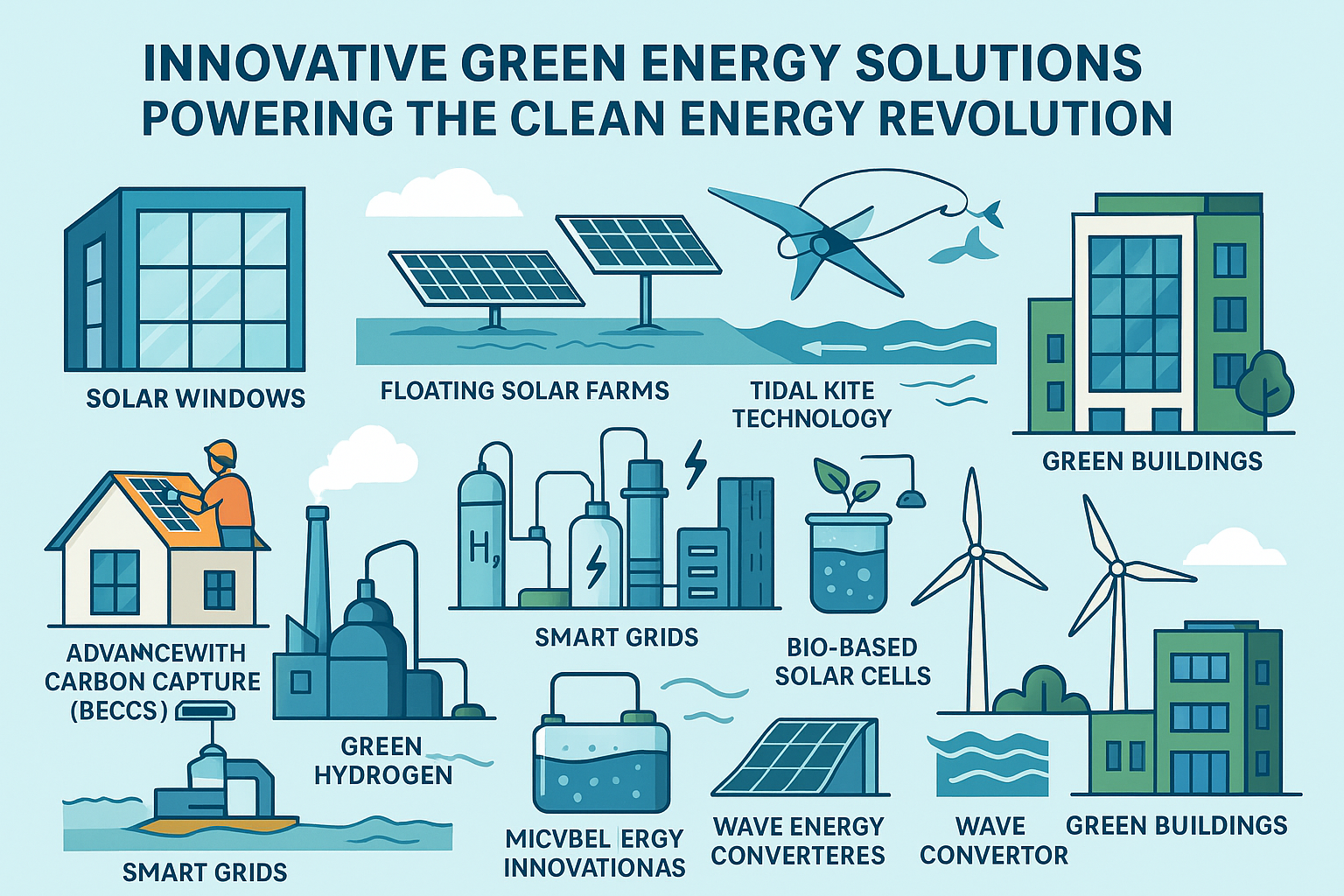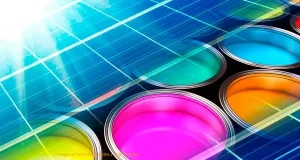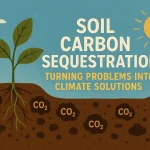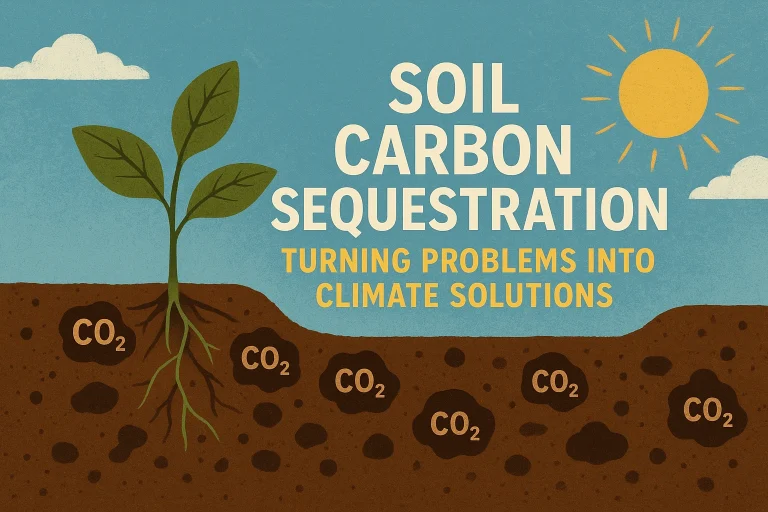
Green Energy Innovations
Green energy innovations Groundbreaking advances in technology are driving the global switch to renewable energy to quicken. More crucial than ever are sustainable energy solutions as the consequences of environmental devastation brought on by traditional fossil fuels show themselves. Ecologically friendly replacements that greatly reduce carbon emissions and pollution include green energy sources, including solar, wind, geothermal, and bioenergy. These technologies are cleaner as well as more reasonably priced and readily available thanks to ongoing developments in efficiency, storage, and integration.
Green energy innovations such as green hydrogen, floating solar farms, and solar windows are altering our generation and consumption of power. And therefore improving the adaptability of renewable energy in many different fields. Not only a technical development but also a necessary reaction to the climate issue and a step toward a sustainable future. Creative green energy solutions supported by consistent investment and cooperation will form the foundation of the worldwide clean energy revolution.
Uncovering the Power of Creating Biofuels: Green Energy Revolution
Solar Windows: Harnessing Energy Through Transparent Technology
Though traditional solar panels are still widely used, solar windows represent a breakthrough in sustainable energy. By combining transparent photovoltaic cells that generate electricity and allow visible light to pass through, these modern windows maintain the utility and beauty of traditional glass. Two benefits of solar windows, meant to replace traditional windows in houses and businesses, are that they are attractive elements and sustainable energy sources.
Incorporating energy generation inside the building itself will help buildings to become vertical power generators, therefore drastically lowering the need for rooftop solar panels. This saves space and increases the visual appeal of modern construction. Urban environments where space is limited and aesthetics are critical benefit especially from solar windows. As technology advances, it is expected that sustainable construction and energy-efficient building design will be vital for helping cities to more gently reduce their carbon footprint.
Floating Solar Farms: Using Water Surfaces for Energy Production
One creative approach to building floating solar farms is to install photovoltaic panels on lakes, reservoirs, and other calm bodies of water’s surfaces. Two benefits of this approach are that it greatly reduces water evaporation, which is crucial in locations with limited water resources, and it maintains valuable land, which is particularly crucial in areas with high population density or extensive agriculture. Moreover, especially in hot climates where solar panel performance may otherwise worsen.
The water under the panels helps to explain their higher energy output and efficiency. This method is very useful in countries where traditional solar farms cannot find enough land. Countries like China and Japan are setting the benchmark with notable spending and floating solar plant deployments. These floating devices cleverly exploit available space and enable the globe to migrate toward greener, more sustainable energy sources. Their effectiveness and scalability make them an interesting weapon for the fight against climate change.
Green Buildings Powered by Renewable Innovations
Green buildings are transforming metropolitan surroundings by means of the incorporation of innovative renewable technologies, including solar paint and windows. These buildings mix clever lighting and HVAC systems with energy-efficient construction to significantly reduce energy consumption. Many are made to be energy-positive, which means they create more energy than they
consume, therefore lowering their total carbon footprint. By combining multiple green technologies, these buildings improve occupant comfort, assist sustainability objectives, and maximize environmental advantages. Thus, reaching urban sustainability goals, building cleaner cities, and so enabling a better environment for current and next generations depend on green buildings.
Bioenergy with Carbon Capture and Storage (BECCS)
Modern technology known as Bioenergy with Carbon Capture and Storage (BECCS) combines carbon removal with renewable energy generation. It works by absorbing carbon dioxide (CO₂) produced from burning or processing biomass—organic materials include agricultural wastes, organic waste, and leftovers from forests. BECCS distinguishes itself from traditional energy systems in that it can produce negative carbon emissions, that is, remove more CO₂ from the environment than it generates.
This quality makes it an indispensable weapon in the fight against climate change and a fundamental component of strategies aiming at net-zero emissions. As world climate targets become more aggressive, BECCS offers a scalable and sustainable method to reduce greenhouse gas concentrations. It also provides organic waste a good use and produces heat or electricity. Many analysts, particularly in countries with significant agricultural or forestry resources, view BECCS as a necessary component of both future national and international energy policies.
Tidal Kite Technology: Generating Power from Ocean Currents
Tidal kite technology is a novel approach for gathering ocean energy. Respected underwater wind turbines, these seabed-tethered kites glide with tidal currents and gather kinetic energy as they do. Unlike stationary tidal turbines, tidal kites have a dynamic figure-eight trajectory that dramatically improves water flow over the rotor, hence improving energy output. Their mobility allows them to generate more power from slower currents; thus, even in places with little tidal flow, they are rather efficient.
Their tiny scale also reduces environmental effects and diminishes disturbance of maritime environments. Perfect for coastal regions with consistent tidal cycles, tidal kites are a very dependable and consistent renewable energy source. Unlike intermittent sources like wind and solar, tides follow moon cycles; hence, they offer a consistent power supply. With ongoing research and financing, tidal kite technology has great potential to assist the worldwide switch to renewable energy sources.
Green Hydrogen: Fueling a Zero-Carbon Economy
Electrolyzing water using renewable energy sources such as sun and wind generates a new clean fuel known as “green hydrogen”. Unlike conventional hydrogen derived from fossil fuels, green hydrogen is necessary for the change to a zero-carbon economy since it generates no greenhouse gas emissions during manufacturing or usage.
Applications for this flexible energy transporter are clean heating for homes and businesses, decarbonization of industrial processes, and fuel-cell vehicle power. One of its most possible applications is long-term energy storage since it can assist in stabilizing systems dependent on intermittent renewable energy sources like solar and wind.
Thanks to recent advancements in electrolyzer technology, which are substantially reducing manufacturing costs, green hydrogen is growing more practical and scalable. As the demand for clean energy grows worldwide, green hydrogen stands out as a sustainable alternative that might replace fossil fuels in sectors generally difficult to decarbonize, therefore paving the path to a better future.
Wave Energy Converters: Harvesting Ocean Surface Power
Promising renewable energy sources, wave energy converters gather energy from the motion of ocean surface waves. Designs like point absorbers and oscillating water columns successfully gather this energy. Because ocean waves are quite consistent, wave energy is a consistent and trustworthy substitute for solar and wind power, which can be erratic. A vital part of future sustainable energy portfolios since wave energy has great potential for expansion in coastal areas all around. Current research aims to cut prices and improve the lifetime of wave energy devices. Thereby increasing the economic viability and broad adoption of this technology.
Advanced Geothermal Systems: Tapping Earth’s Inner Heat
Drawing on the Earth’s natural heat buried under the surface, geothermal energy generates pure, renewable electricity. Unlike the erratic character of solar and wind energy, geothermal energy offers a constant, uninterrupted source available around the clock. Recent advances in drilling technology make more efficient access to deeper geothermal reserves possible. A major breakthrough that creates artificial subsurface reservoirs in hot, dry rock formations when natural water flow is insufficient is enhanced geothermal systems (EGS).
By pumping fluid into these reservoirs, EGS enables heat extraction in areas once unfit for geothermal development. This development extends the global potential of geothermal energy by making it possible in places outside the typical volcanic zones. EGS may thus be absolutely necessary for supporting decarbonization, diversifying national energy portfolios, and providing consistent baseload electricity. With continuous investment and creativity, advanced geothermal systems might be a major component of the global clean energy transition.
Solar Paint: Turning Surfaces into Power Generators

Modern solar paint uses photovoltaic nanoparticles to convert sunlight into electricity. Unlike traditional solar panels, which may be placed on only one surface—such as walls, rooftops, or even vehicles—this paint provides an extremely flexible energy source. Its versatility means that, especially on curved or uneven surfaces, it could generate electricity from formerly underutilized areas.
Without big hardware, this opens fresh chances for including renewable energy in buildings, transportation, and infrastructure. Solar paint is yet in the experimental stage, so studies are now in progress to raise its price, lifetime, and efficiency. As the technology develops, solar energy collecting could be transformed, helping to embrace distributed, sustainable power solutions and so reducing future reliance on fossil fuels for homes, businesses, and perhaps whole communities.
Smart Grids and Energy Storage Integration
Smart grids, the next iteration of energy distribution networks, enhance the flow of electricity by using innovative technologies such as artificial intelligence (AI) and the Internet of Things (IoT). Through constant monitoring and analysis of consumption patterns, smart grids can instantly balance energy supply and demand. This considerably lessens the usual waste and inefficiency of conventional grids. One of their key benefits is how well smart grids mix with energy storage technologies, particularly battery systems.
This mix increases general grid reliability by storing extra renewable energy, such as solar and wind, during periods of peak output and releasing it during periods of low generation or great demand. Smart grids thus promote higher resilience and energy independence, which makes renewable energy sources more sensible even if they are sporadic. Thanks to real-time usage data, customers will gain from lower electricity rates, improved service dependability, and greater transparency, thereby enabling them to make informed energy decisions and help create a cleaner, more sustainable future.
Microbial Fuel Cells: Using Bacteria to Produce Energy
Microbial fuel cells (MFCs) generate electricity using the natural metabolic activities of microorganisms. These cells efficiently convert organic waste products into electrical power, so they offer a sustainable and ecologically friendly source of it. Apart from generating electricity, MFCs offer innovative wastewater treatment options by breaking down pollutants concurrently. MFCs have great potential for a variety of practical applications even if they are still young. Their use in running off-grid systems, low-energy gadgets, and remote sensors will help future developments in sustainable energy and environmental management much as they will benefit others. Green energy innovations like solar windows, floating solar farms, and green hydrogen are altering our generation and consumption of electricity.
Bio-Based Solar Cells: Sustainable Alternatives to Silicon Panels
Bio-based solar cells are a fascinating and ecologically beneficial alternative to traditional silicon-based solar panels. Since their organic components—which come from plants or algae—these new cells are biodegradable and ecologically friendly. Their lightweight and flexible nature helps them to be employed in settings where stiff silicon panels cannot, like on portable devices or curved surfaces. Moreover, bio-based solar cells utilize far less energy during manufacturing than conventional silicon panels, therefore reducing their total carbon footprint. Researchers are actively trying to extend the lifetime.
And energy conversion efficiency of these cells so they can be more competitive with present solar technologies. Special properties of bio-based solar cells make them perfect for wearable technology, portable chargers, and other uses demanding flexible, lightweight, and sustainable energy sources. Future renewable energy might depend much on this invention. Our generation and consumption of electricity are changing thanks to green energy innovations including solar windows, floating solar farms, and green hydrogen.
Wind Energy Innovations: Vertical Axis Turbines and Airborne Wind Power
Vertical axis wind turbines (VAWTs) and airborne wind power systems are two interesting fresh advances in wind energy technology. Unlike conventional horizontal turbines, VAWTs are especially successful in complex and metropolitan settings where wind patterns are often chaotic and turbulent, as they can gather wind from any direction. Their small scale allows them to be placed in smaller spaces, such as rooftops or city streets, therefore enhancing the local possibilities for generating wind power. Conversely.
Airborne wind power gathers the stronger and more consistent winds seen at higher elevations using tethered kites or drones. These devices considerably increase energy output. And dependability by reaching heights stationary turbines cannot. One prospective substitute for conventional wind farms is the harnessing of high-altitude winds by flying equipment. Taken all together, these advancements expand the range and adaptability of wind energy, therefore enhancing its appeal and diversity worldwide as a renewable energy source’ Green energy innovations.
Conclusion: The Path Forward
Green energy innovations solutions are drastically transforming the global energy scene by offering competitive substitutes to long-dominant fossil fuels. These creative ideas are absolutely vital if we are to reduce carbon emissions, mitigate the effects of climate change, and protect the environment for the next generations. These discoveries must, however, be fully realized by sustained investment and ongoing research if we are to raise productivity, lower prices, and scale manufacturing.
The advancement of the clean energy transition depends on great cooperation among governments, business enterprises, scientific communities, and local stakeholders. Policy backing, financing projects, and public participation are vital if we are to hasten the acceptance and integration of renewable energy systems all around. Apart from helping to reach world climate targets, these projects will boost economic growth, create green employment, and strengthen energy security. Ultimately, the clean green energy innovations revolution promises everyone a more robust, rich, and sustainable future.
I’m a passionate blogger with a degree in APD Computer Science, blending technical expertise with a love for sharing knowledge. Through my blog, I explore the intersections of technology, creativity, and practical insights, offering readers valuable perspectives on topics that matter. Whether it’s diving into the latest tech trends, sharing productivity hacks, or simplifying complex concepts, my goal is to inspire and inform with every post.











